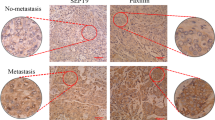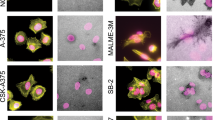Abstract
Tumor cell invasion is a highly integrated and complex process comprising several biologically distinct functions such as cell adhesion, motility, proteolysis, etc. Visinin-like protein-1 (VILIP-1), a member of the neuronal EF-hand calcium-sensor protein family, plays a role in regulating tumor cell invasiveness of mouse squamous cell carcinoma (SCC). VILIP-1 enhances cyclic adenosine monophosphate levels through PKA induction. However, the mechanism by which VILIP-1 reduces cell invasiveness is not well understood. In this study, we show that VILIP-1 decreased cell adhesion and migration/invasiveness of highly invasive mouse SCC cells. Forced expression of VILIP-1 reduced cell adhesion to fibronectin in parallel to downregulating αv and α5 integrin subunit levels. VILIP-1 overexpression also led to decreased migration ability. Conversely, short hairpin RNA-mediated VILIP-1 knock-down of SCC cells' characterized by little or no invasiveness, correlated with increased adhesion to fibronectin and enhanced expression of αv and α5 integrin subunits together with increased cell migration. Function-blocking assays with inhibitory anti-α5 and anti-αv integrin antibodies showed that both subunits contributed to cell adhesion, migration, and invasiveness of highly invasive SCC cell lines. These results point to a critical role of VILIP-1 in regulating cell adhesion and migration by downregulation of fibronectin receptor expression. Decreased or absent VILIP-1 expression in SCC cell subpopulations may lead to a more advanced malignant phenotype characterized by changes in adhesive ability and increased cell motility, suggestive of a tumor suppressor function.
This is a preview of subscription content, access via your institution
Access options
Subscribe to this journal
Receive 50 print issues and online access
$259.00 per year
only $5.18 per issue
Buy this article
- Purchase on Springer Link
- Instant access to full article PDF
Prices may be subject to local taxes which are calculated during checkout







Similar content being viewed by others
Abbreviations
- VILIP-1:
-
visinin like protein-1
- cAMP:
-
cyclic adenosine monophosphate
- ECM:
-
extracellular matrix
- SCC:
-
squamous cell carcinoma
References
Adams JC and Watt FM . (1991). J. Cell Biol., 115, 829–841.
Bagutti C, Speight PM and Watt FM . (1998). J. Pathol., 186, 8–16.
Felding-Habermann B, Fransvea E, O’Toole TE, Manzuk L, Faha B and Hensler M . (2002). Clin. Exp. Metast., 19, 427–436.
Gong J, Wang D, Sun L, Zborowska E, Willson JK and Brattain MG . (1997). Cell Growth Differ., 8, 83–90.
Haapasalmi K, Zhang K, Tonnesen M, Olerud J, Sheppard D, Salo T, Kramer R, Clark RA, Uitto VJ and Larjava H . (1996). J. Invest. Dermatol., 106, 42–48.
Hood JD and Cheresh DA . (2002). Nat. Rev. Cancer, 2, 91–100.
Huang S, Stupack D, Liu A, Cheresh D and Nemerow GR . (2000). Oncogene, 19, 1915–1923.
Hubbard FC, Goodrow TL, Liu SC, Brilliant MH, Basset P, Mains RE and Klein-Szanto AJ . (1997). Cancer Res., 57, 5226–5231.
Jin H and Varner J . (2004). Br. J. Cancer, 90, 561–565.
Jones J, Watt FM and Speight PM . (1997). J. Oral Pathol. Med., 26, 63–68.
Kassis J, Lauffenburger DA, Turner T and Wells A . (2001). Semin. Cancer Biol., 11, 105–117.
Kerr JS, Slee AM and Mousa SA . (2002). Expert Opin. Investig. Drugs, 11, 1765–1774.
Kikuchi M, Ma TY, Tarnawski AS, Shimada H and Sarfeh IJ . (1997). J. Gastrointest. Surg., 1, 132–137.
Kim S, Harris M and Varner JA . (2000). J. Biol. Chem., 275, 33920–33928.
Koivisto L, Grenman R, Heino J and Larjava H . (2000). Exp. Cell Res., 255, 10–17.
Koivisto L, Larjava K, Hakkinen L, Uitto VJ, Heino J and Larjava H . (1999). Cell Adhes. Commun., 7, 245–257.
Koukoulis GK, Warren WH, Virtanen I and Gould VE . (1997). Hum. Pathol., 28, 1018–1025.
Larjava H, Salo T, Haapasalmi K, Kramer RH and Heino J . (1993). J. Clin. Invest., 92, 1425–1435.
Li X, Regezi J, Ross FP, Blystone S, Ilic D, Leong SP and Ramos DM . (2001). J. Cell Sci., 114, 2665–2672.
Ma TY, Kikuchi M, Sarfeh IJ, Shimada H, Hoa NT and Tarnawski AS . (1999). J. Lab. Clin. Med., 134, 363–371.
Mahloogi H, Gonzalez-Guerrico AM, Lopez De Cicco R, Bassi DE, Goodrow T, Braunewell KH and Klein-Szanto AJ . (2003). Cancer Res., 63, 4997–5004.
Mercurio AM and Rabinovitz I . (2001). Semin. Cancer Biol., 11, 129–141.
Nagaoka K, Nojima H, Watanabe F, Chang KT, Christenson RK, Sakai S and Imakawa K . (2003). J. Biol. Chem., 278, 29048–29056.
O’Connor KL, Nguyen BK and Mercurio AM . (2000). J. Cell Biol., 148, 253–258.
O’Connor KL, Shaw LM and Mercurio AM . (1998). J. Cell Biol., 143, 1749–1760.
Paddison PJ, Caudy AA, Bernstein E, Hannon GJ and Conklin DS . (2002). Genes Dev., 16, 948–958.
Paddison PJ, Caudy AA, Sachidanandam R and Hannon GJ . (2004). Methods Mol. Biol., 265, 85–100.
Peltonen J, Larjava H, Jaakkola S, Gralnick H, Akiyama SK, Yamada SS, Yamada KM and Uitto J . (1989). J. Clin. Invest., 84, 1916–1923.
Reinmuth N, Liu W, Ahmad SA, Fan F, Stoeltzing O, Parikh AA, Bucana CD, Gallick GE, Nickols MA, Westlin WF and Ellis LM . (2003). Cancer Res., 63, 2079–2087.
Rolli M, Fransvea E, Pilch J, Saven A and Felding-Habermann B . (2003). Proc. Natl. Acad. Sci. USA, 100, 9482–9487.
Ruggeri B, Caamano J, Goodrow T, DiRado M, Bianchi A, Trono D, Conti CJ and Klein-Szanto AJ . (1991). Cancer Res., 51, 6615–6621.
Santibanez JF, Olivares D, Guerrero J and Martinez J . (2003). Int. J. Cancer, 107, 715–720.
Shiraha H, Glading A, Chou J, Jia Z and Wells A . (2002). Mol. Cell. Biol., 22, 2716–2727.
Takahashi K, Nakamura T, Koyanagi M, Kato K, Hashimoto Y, Yagita H and Okumura K . (1990). J. Immunol., 145, 4371–4379.
Thomas GJ, Lewis MP, Hart IR, Marshall JF and Speight PM . (2001a). Int. J. Cancer, 92, 641–650.
Thomas GJ, Lewis MP, Whawell SA, Russell A, Sheppard D, Hart IR, Speight PM and Marshall JF . (2001b). J. Invest. Dermatol., 117, 67–73.
Woodhouse EC, Chuaqui RF and Liotta LA . (1997). Cancer, 80, 1529–1537.
Yasuda M, Hasunuma Y, Adachi H, Sekine C, Sakanishi T, Hashimoto H, Ra C, Yagita H and Okumura K . (1995). Int. Immunol., 7, 251–258.
Zhang Z, Morla AO, Vuori K, Bauer JS, Juliano RL and Ruoslahti E . (1993). J. Cell Biol., 122, 235–242.
Acknowledgements
This work was supported in part by a grant from the National Institutes of Health CA06927 and by an appropriation from the Commonwealth of Pennsylvania.
Author information
Authors and Affiliations
Corresponding author
Rights and permissions
About this article
Cite this article
Gonzalez Guerrico, A., Jaffer, Z., Page, R. et al. Visinin-like protein-1 is a potent inhibitor of cell adhesion and migration in squamous carcinoma cells. Oncogene 24, 2307–2316 (2005). https://doi.org/10.1038/sj.onc.1208476
Received:
Revised:
Accepted:
Published:
Issue Date:
DOI: https://doi.org/10.1038/sj.onc.1208476
Keywords
This article is cited by
-
Detection of genome-wide copy number variations in two chicken lines divergently selected for abdominal fat content
BMC Genomics (2014)
-
Calcium binding protein-mediated regulation of voltage-gated calcium channels linked to human diseases
Acta Pharmacologica Sinica (2011)
-
Visinin-like proteins (VSNLs): interaction partners and emerging functions in signal transduction of a subfamily of neuronal Ca2+-sensor proteins
Cell and Tissue Research (2009)
-
Functional Contribution of Ca2+ and Mg2+ to the Intermolecular Interaction of Visinin-like Proteins
The Protein Journal (2006)



